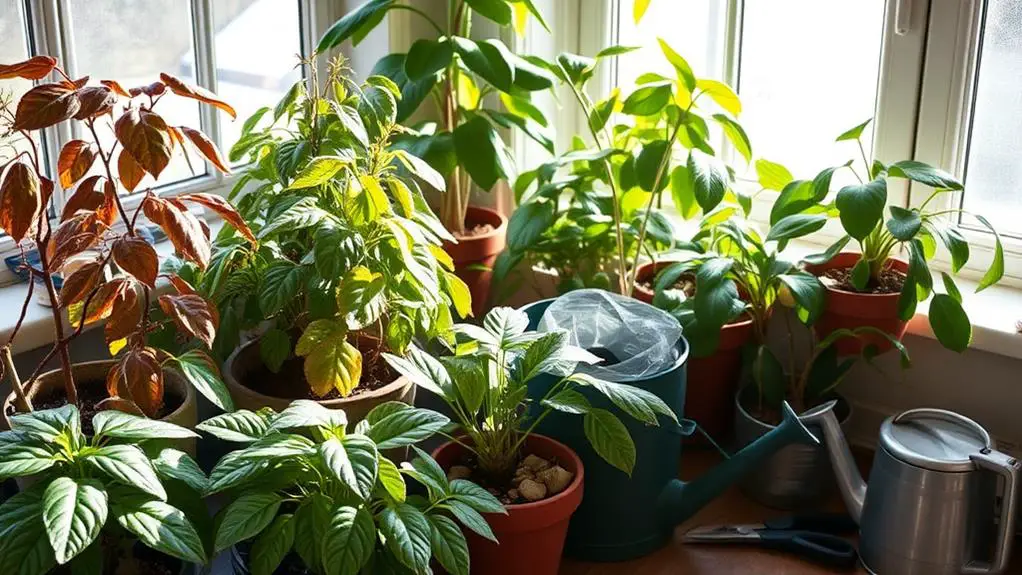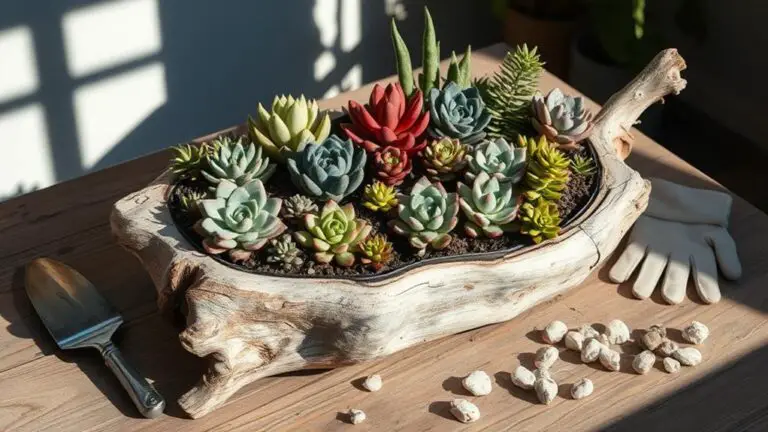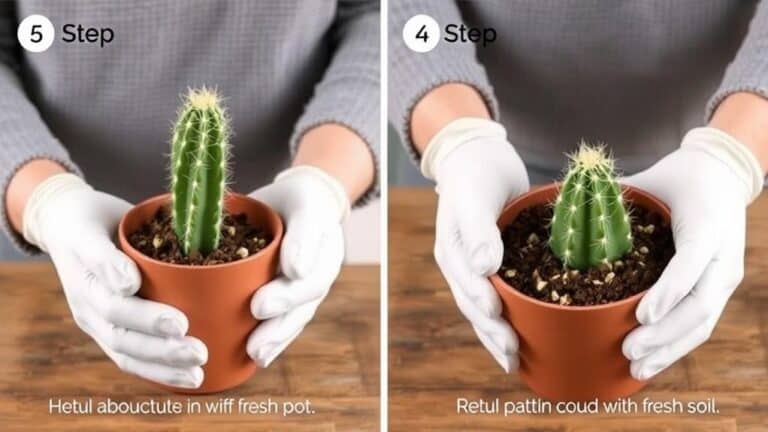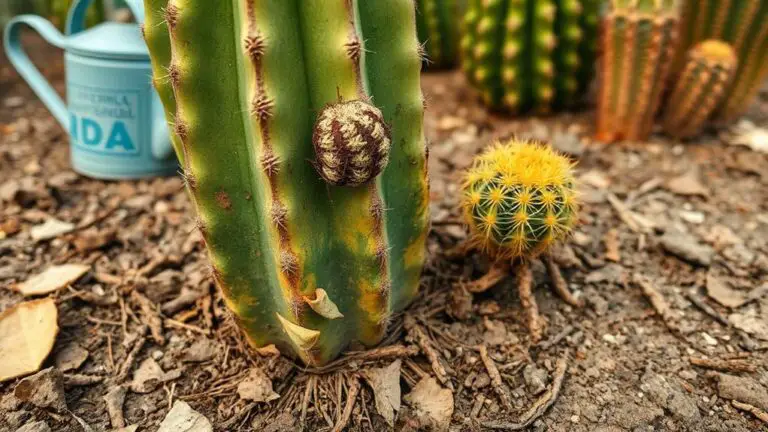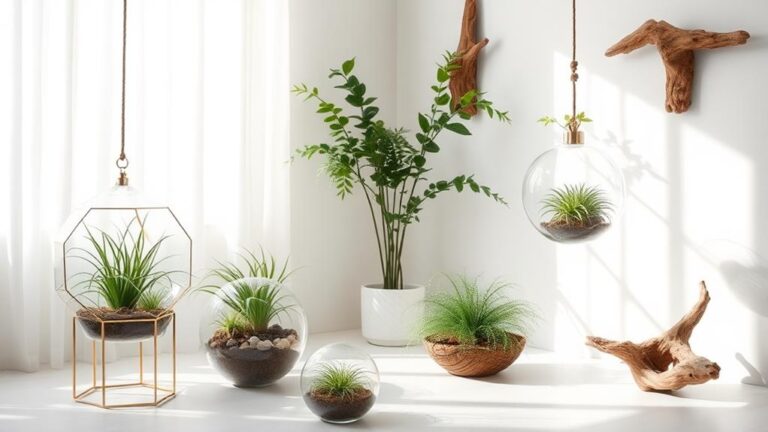10 Signs and Tips to Treat Frost Damage in Houseplants
You've probably noticed the wilting leaves and discoloration on your houseplants, especially during colder months, and wondered what's going on. Frost damage can be a real issue, but it's not the end for your beloved plants. By understanding the common signs and knowing how to treat them, you can nurse your plants back to health. Relocating them to a warmer spot, trimming away the damaged parts, and adjusting your care routine are just a few steps you can take. Want to guarantee your plants thrive even during winter? Let's explore how to spot and treat frost damage effectively.
What Is Frost Damage?
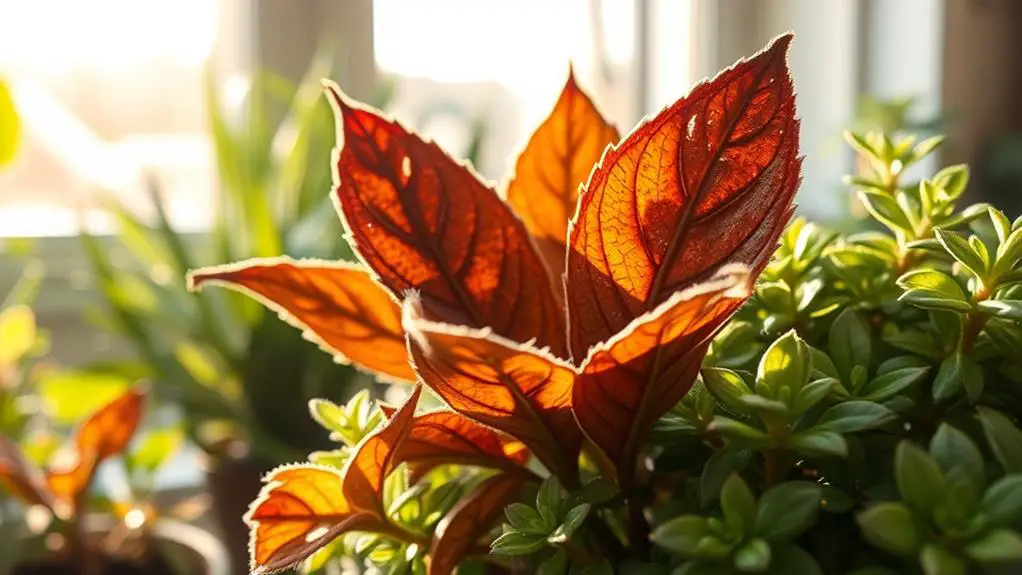
Frost damage happens when temperatures dip below freezing (32°F or 0°C), causing the water inside plant cells to freeze and expand. When this happens, the cell walls rupture, leading to tissue damage.
You'll notice visible signs such as wilting leaves, discoloration, and blackened or mushy tissue. Tropical plants are especially vulnerable since they're not adapted to cold conditions.
If temperature drops suddenly, young leaves, flowers, and buds can suffer the most. While mature cells and roots might survive better due to protection from bark and soil, frost damage can still be severe if exposure is prolonged.
Causes of Frost Damage

Frost damage happens when temperatures fall below freezing, causing ice crystals to form inside your plant's cells.
These ice crystals expand, rupturing cell walls and leading to damaged or dying plants.
Your houseplants are especially susceptible during sudden cold snaps or chilly nights, so it's important to monitor temperatures closely.
Temperature Drops' Impact
When temperatures plummet below freezing, the water inside plant cells freezes and expands, leading to cell rupture and tissue damage. This frost damage often happens when temperatures drop below 32°F, but even temperatures below 50°F can harm sensitive houseplants, especially with prolonged exposure.
To understand the impact, consider these factors:
- Duration of Exposure: Prolonged exposure of 12-24 hours can be lethal.
- Humidity Levels: High moisture levels increase cooling effects, worsening tissue injury.
- Wind: Wind elevates the cooling effect, causing more significant damage.
Signs of frost damage include wilted or blackened leaves, mushy plant tissues, and stunted growth. Monitoring weather and providing protection can help minimize damage.
Ice Crystal Formation
Understanding how temperature drops impact houseplants is a step towards grasping the underlying causes of frost damage.
When temperatures fall below freezing, water inside the plant cells freezes, forming ice crystals. These ice crystals expand, causing cell rupture and tissue damage. As a result, the plant struggles to transport nutrients and water effectively.
Plants with high moisture content are especially prone to this type of damage. Signs of frost damage include wilting, discoloration, and blackened or mushy leaves.
Sensitive species may suffer greatly as the ice crystals disrupt the cellular balance. By recognizing these signs early, you can take steps to protect your houseplants from frost damage and help them recover more quickly.
Visible Signs of Damage

When your houseplants face frost damage, you'll notice several visible signs that they're in trouble.
Wilting and discoloration are common, with leaves turning pale, yellow, or even white.
You might also see blackened foliage or mushy stems, and in severe cases, leaves can become soggy or fall off.
Wilting and Discoloration
Frost damage in houseplants often reveals itself through wilting and discoloration, clear indicators that your plants are struggling.
When leaves wilt, it's because the freezing temperatures have disrupted their ability to transport water. Discoloration, on the other hand, shows up as leaves change from vibrant green to pale, yellow, or even white, signaling cell damage and loss of chlorophyll.
To identify and monitor frost damage, look for these signs:
- Wilting leaves: They appear droopy and lifeless.
- Discoloration: Leaves shift in color, often becoming lighter or yellow.
- Delayed symptoms: Damage may not show immediately, so keep checking for several days.
Blackened Foliage Indicators
Blackened foliage serves as one of the most glaring signs that your houseplants have suffered frost damage.
You'll notice this especially at the leaf edges and tips, where ice crystals form and rupture cell walls. In light frost cases, the affected leaves might turn brown or black, progressing to complete wilting if the damage worsens.
Severe frost can make entire leaves soggy or mushy, signaling significant cellular damage. Flowers and buds aren't immune either; they can show discoloration and wilting, impacting reproduction.
If stems are hit, they might collapse or turn mushy, with tougher stems possibly losing leaves. Recognizing these signs early helps you treat frost damage and save your precious plants.
Texture and Leaf Drop**
Besides blackened foliage, frost damage in houseplants also reveals itself through changes in texture and leaf drop.
When frost hits, you might notice:
- Wilting Leaves: Leaves may become limp due to disrupted water transport.
- Discoloration: Leaves can change from green to pale, yellow, or white, indicating cell damage.
- Soft or Mushy Texture: Frost-damaged areas often feel soft or mushy because of cell death.
Leaf drop is another common sign.
Frost-damaged plants might shed leaves to save energy and reduce stress.
Some plants show damage right away, but others take a few days.
Keep an eye on your plants for these signs to act quickly in treating and supporting them.
You've got this!
High-Risk Houseplants

When it comes to houseplants, certain species are particularly vulnerable to frost damage. High-risk houseplants, especially tropical species like Echeveria, Crassula, Fiddle Leaf Fig, and various Philodendron varieties, aren't adapted to freezing temperatures.
Sensitive ferns and palms, such as the Areca Palm and Parlor Palm, also fall into this category. Exposure to temperatures below 50°F can cause immediate frost damage, showing symptoms like yellowing leaves and wilting within days. The young leaves, flowers, and buds are especially at risk.
To prevent frost damage, you must monitor weather forecasts closely. Bring these high-risk houseplants indoors or move them to sheltered areas before exposure to freezing temperatures. This proactive step can save your plants from irreversible harm.
Immediate Actions to Take
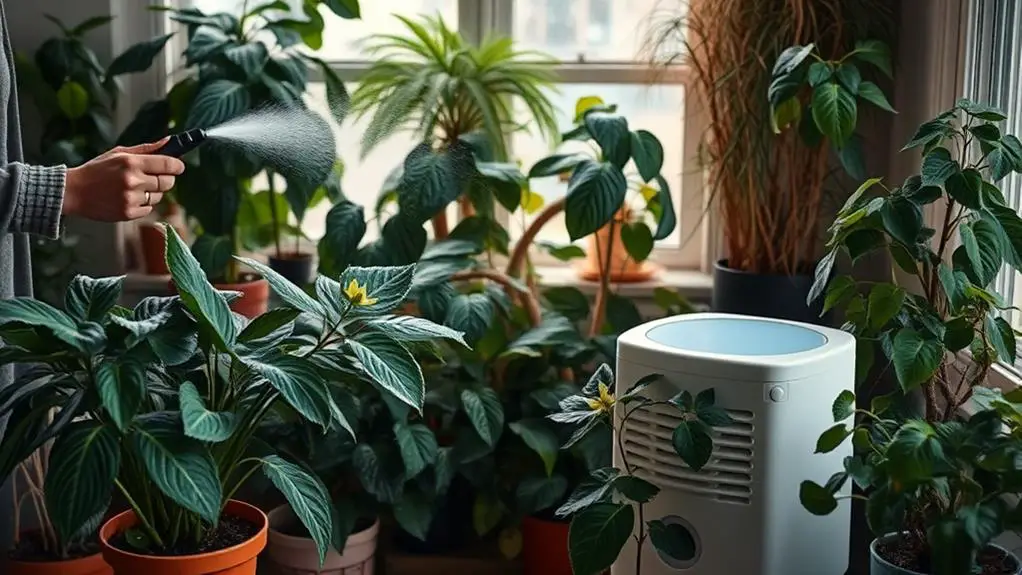
If your houseplants have been exposed to frost, the first step is to immediately relocate them to a warmer area away from drafts. This helps minimize further damage and stress.
Next, assess visible damage by checking for signs like wilting, discoloration, and dead tissue.
Here's what you should do:
- Trim damaged leaves: Use clean shears to remove dead or severely damaged parts.
- Water sparingly: Frost-affected plants need less moisture, so avoid overwatering.
- Monitor plants: Watch for signs of new growth to see if they recover from frost.
Pruning Damaged Parts

When pruning frost-damaged parts of your houseplants, start by evaluating the severity of the damage with care.
Use clean, sharp shears to trim away any blackened or mushy tissues, which can prevent the plant from recovering properly.
Remember to only remove up to one-third of the foliage at a time to avoid stressing the plant and encourage healthy growth.
Assessing Damage Severity
To properly evaluate frost damage severity in your houseplants, start by carefully examining for signs such as wilting, discoloration, and dead tissue, particularly on the most affected leaves and stems.
When evaluating frost damage, follow these steps:
- Check for Wilting: Look for droopy or limp leaves.
- Note Discoloration: Identify any brown, black, or yellow patches.
- Examine Dead Tissue: Focus on dry, brittle areas.
Use clean, sharp shears to prune damaged parts, cutting back to healthy tissue. Avoid pruning too aggressively; retain more than two-thirds of each leaf. This helps the plant recover while promoting airflow.
Monitor your plant for new growth after pruning as it's a good sign of recovery. Be patient—recovery may take weeks or months.
Proper Pruning Techniques
Pruning frost-damaged parts of your houseplants is essential for their recovery. Start by evaluating the plant's health to avoid stressing it further.
Use clean, sharp shears to cut away damaged leaves and stems. Trim back any dead or mushy tissue until you reach healthy, green growth. Make sure to leave at least two-thirds of each leaf intact to support recovery.
When making cuts, do so at a slight angle to help water run off and reduce rot risk. After pruning, let your plant acclimate in a warm environment and don't fertilize until you see new growth. This helps reduce nutrient needs and encourages healthy regrowth.
With these pruning techniques, your houseplants will be on their way to recovery.
Encouraging Healthy Growth
Once you've pruned the frost-damaged parts of your houseplants, the next step is to encourage healthy growth. This means focusing on simple, effective care routines.
Here's what you can do:
- Monitor for new growth: Keep an eye on your plant. New leaves or stems mean it's recovering and redirecting energy towards healthier growth.
- Avoid excessive pruning: Remove only the most affected areas to maintain the plant's overall health. Over-pruning can stress it out.
- Support its rejuvenation: Adjust your watering and care routines. Make sure the plant gets the right amount of light, water, and nutrients.
Be patient and continue these practices to promote healthier growth. With careful attention, your houseplant will thrive again.
Recovery Care Tips

Nurturing your houseplants back to health after frost damage requires a blend of patience and attentive care.
Start by relocating your plants to a warmer spot, away from drafts, to promote recovery. Trim off any damaged leaves or stems with clean shears to help new, healthy growth.
Water sparingly, allowing the soil to dry out between waterings, as damaged plants don't need much water initially. Maintain moderate humidity and light conditions, avoiding direct sunlight which can stress the plants.
Monitor your plants closely for signs of new growth—it's a good indicator that they're recovering.
Preventing Frost Damage

While it's crucial to know how to care for houseplants after frost damage, preventing the damage in the first place can save you a lot of trouble.
To keep your plants safe during cold weather, follow these steps:
- Monitor weather conditions regularly: When temperatures are forecasted to drop below 60°F, bring houseplants indoors or to sheltered locations.
- Use frost cloths or blankets: Cover outdoor plants during cold spells to provide insulation against freezing temperatures.
- Acclimatize plants gradually: If they've been outdoors, help them adjust to indoor conditions slowly to prevent additional stress.
Ensure proper drainage and avoid overwatering during colder months to reduce the risk of frost damage and root rot.
Taking these precautions will help your plants thrive even in chilly weather.
Seasonal Awareness

Keeping an eye on seasonal changes is key to protecting your houseplants from frost damage. Seasonal awareness means staying informed about local frost dates and weather forecasts. By monitoring these, you can take proactive measures to safeguard your plants from cold temperatures.
Most houseplants are sensitive to temperatures below 60°F, so it's essential to adjust your care routines accordingly. Create a plant care calendar to remind you when to move vulnerable plants indoors before frost hits and to check them regularly during winter.
Make sure to educate yourself on each plant's cold tolerance. This will help you provide the best care and keep them healthy through seasonal shifts. Stay proactive, and your plants will thrive.
Helpful Resources
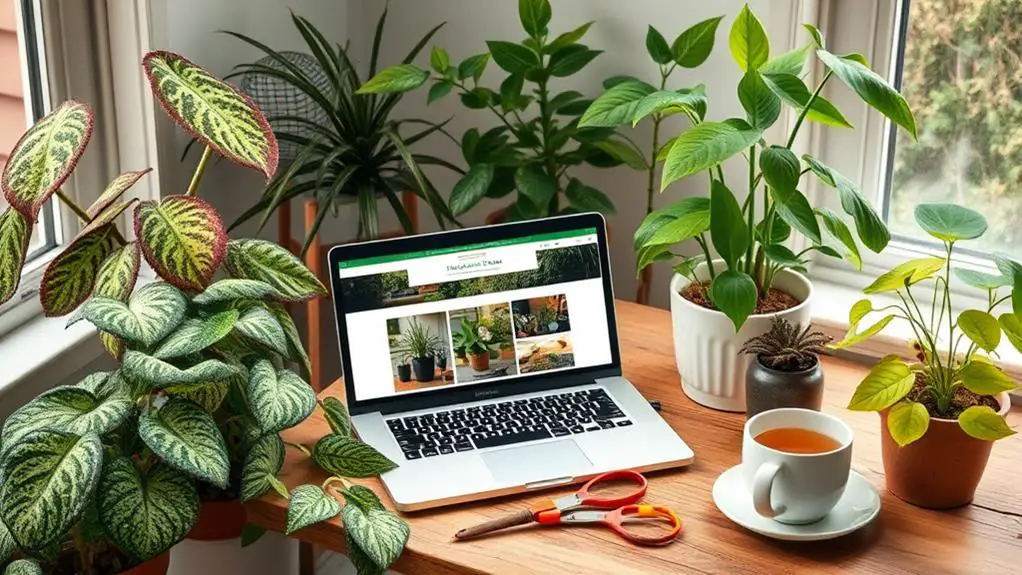
Often, finding the right resources can make all the difference in treating frost damage in houseplants.
You've got plenty of options to help your plants recover. Here are three helpful resources:
- Online Gardening Forums: Join communities where plant enthusiasts share experiences and tips. You'll gain insights on frost damage and recovery.
- Gardening Experts: Reach out to local horticultural societies or consult experts for tailored plant care advice. Their knowledge can be invaluable.
- Reliable Websites and Blogs: Access extensive information on plant care and frost damage from trusted sites like Larry Hodgson's gardening blog.
Books on indoor gardening and subscription services offering seasonal guidance are also great resources.
With the right help, your houseplants can bounce back beautifully.
Frequently Asked Questions
Can a House Plant Recover From Frost?
Yes, your houseplant can recover from frost damage. Relocate it to a warmer spot and wait a week to prune damaged parts. Make certain it gets moderate humidity and adequate light. Monitor for new growth to gauge recovery.
How to Tell if Plants Have Frost Damage?
You can tell if plants have frost damage by looking for wilting, discoloration, and mushy stems. Leaves might turn pale, yellow, or black. Monitor closely after cold exposure for any limp or crinkly leaves.
How to Treat Frost Damaged Plants?
Move frost-damaged plants to a warmer spot without drafts. Check for damage and prune dead parts with clean shears. Water sparingly, avoid fertilizing until new growth appears, and monitor closely, adjusting care for ideal recovery.
What Do Frost Damaged Leaves Look Like?
You'll notice frost-damaged leaves by their discoloration, shifting to pale yellow or white. Edges turn brown or black, and severely affected leaves become mushy or drop off. Wilting and drooping are also common indicators.
Conclusion
You've got this! By recognizing the signs of frost damage and taking quick action, you're giving your houseplants the best chance to recover. Remember to keep them warm, trim damaged parts, and water carefully. Regularly check for new growth and adjust your care routine as needed. Stay aware of weather forecasts to protect your plants in the future. With a little attention and care, your houseplants will thrive again. Happy gardening!

